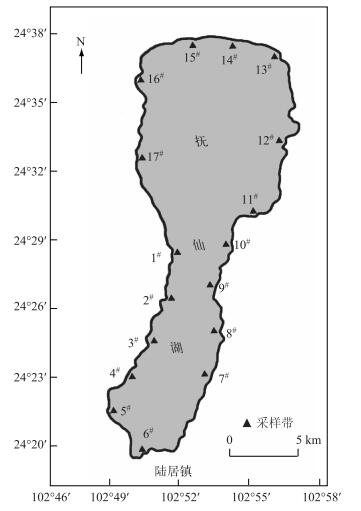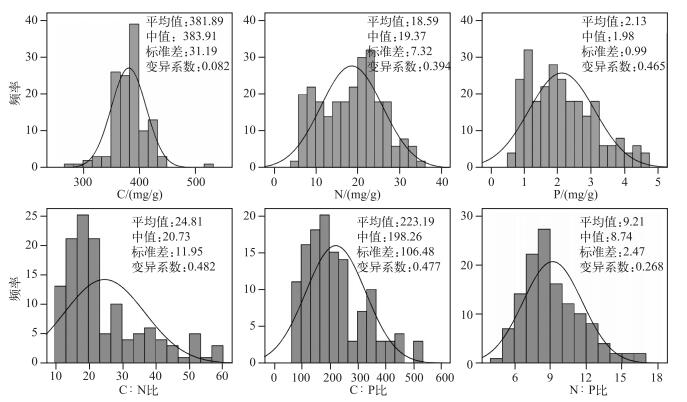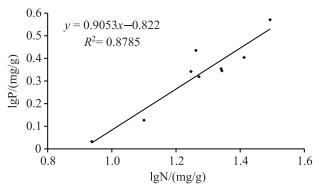(2: 江西省水利科学研究院, 江西省鄱阳湖水资源与环境重点实验室, 南昌 330029)
(3: 中国科学院水生生物研究所东湖湖泊生态系统试验站, 武汉 430072)
(2: Jiangxi Provincial Key Laboratory of Water Resources and Environment of Poyang Lake, Jiangxi Institute of Water Sciences, Nanchang 330029, P. R. China)
(3: Donghu Experimental Station of Lake Ecosystems, State Key Laboratory of Freshwater Ecology and Biotechnology, Institute of Hydrobiology, Chinese Academy of Sciences, Wuhan 430072, P. R. China)
沉水植物是河流和湖泊中重要的初级生产力,既能通过茎和叶吸收水柱中的营养,也能通过根吸收底泥中的营养,对于维持湖泊生态系统结构、养分循环和清水稳态至关重要[1-2].近几十年来,随着湖泊富营养化加剧,水体透明度下降,水体较低的光照强度和较高的营养水平及其交互作用产生的胁迫导致沉水植被衰退严重[3-4].要想成功修复沉水植被,需要了解不同营养水平水体对沉水植物的生理生态方面的影响以及沉水植物的适应性.相关研究表明,如果周围环境营养很充足,水生植物能够积累超过它们所需要的营养物质,一方面是储存营养物质,另一方面也减小了环境过高的营养对植物的胁迫作用[5-6],而植物在过度积累营养物质的同时也消耗大量的碳水化合物,不利于植物的生长[3-4, 6].
碳(C)、氮(N)和磷(P)是重要的生命元素[7],植物C、N和P含量及其比值常广泛地被用来评估环境营养元素的可利用性及其对植物生长的限制程度[8-10].如Koerselman等[8]的研究表明, 当湿生植物N:P比 < 14时N为生态系统限制因子,N :P比>16时P为限制因子;而Güsewell等[9]的研究表明只有当N或P为生态系统限制因子时,利用N :P比来判定植物营养限制类型才是有效的.目前国内对于沉水植物C、N和P的野外研究主要集中在中营养或富营养化水体[11-16],而这些水体的营养可能已经不是限制因子.吴爱平等[12]的研究表明, 水生植物能够富集水柱中过剩的营养; Cao等[3-4]的研究表明, 水柱高营养和低光照能够对沉水植物产生胁迫,使其积累过多营养,消耗大量碳水化合物.贫营养湖泊与富营养湖泊相反,具有营养浓度低、透明度高等特点,所以贫营养湖泊中沉水植物C、N和P的积累特征有可能与中/富营养湖泊差异较大.随着人类活动的加剧,湖泊富营养化的进程也越来越快,湖泊沉水植被退化严重,目前国内贫营养湖泊已经越来越少了,因此掌握贫营养湖泊沉水植物元素含量特征,研究沉水植物在贫营养湖泊与富营养湖泊的营养代谢差异,已经显得十分必要和紧迫.本研究基于典型贫营养湖泊——抚仙湖中常见的9种沉水植物的调查,研究其组织C、N和P化学计量学特征,这有助于我们全面了解沉水植物元素循环及湖泊生物地球化学过程,也有助于为富营养化湖泊沉水植被的修复提供理论支持.
1 材料和方法 1.1 湖泊概况抚仙湖(24°21′~24°38′N, 102°49′~102°57′E)是我国第二深水湖泊,位于云南省中部,是高原内陆断陷湖,属于珠江流域南盘江水系,最深处约155 m,平均水深约89.6 m,面积约211 km2[17-18].近几十年来抚仙湖水体营养水平有所提高,其沉水植物总生物量和分布范围显著增加,但相对于其它富营养湖泊,抚仙湖仍属于贫营养水平湖泊[19-20].
1.2 采样方法与指标测定于2012年8月在抚仙湖全湖布设17个采样带(图 1),每个样带面积约为100 m*100 m,每个样带在不同水深处至少设置18个样方,每个样方面积约为0.2 m2,样方间隔约为10 m.采样工具为手动旋转镰刀式沉水植物采集器,采集沉水植物地上部分,能够采集的最大深度为6.6 m,分布水深超过6.6 m的沉水植物使用彼得森采泥器采集.每个样方采集到的沉水植物用湖水清洗掉附着物,按种类分开,每种植物取完整的地上部分带回实验室处理.每个样带用透明度盘测定水体透明度(SD),用水下照度计(UWQ-192S和Li-1400, Li-Cor, Lincoln, NE)测量水体表层、1、2和3 m处光照强度(为避免风浪造成干扰过大,每个水位光照强度读取5个数值做重复),各样带取表层以下5 cm处水样带回实验室处理.

|
图 1 抚仙湖采样带分布示意 Fig.1 Distribution of the transects in Lake Fuxian |
从现场采集回来的水样按照国标方法(SL88-2012,GB 11894-1989,GB 7479-1987,GB 11893-1989)处理并测定水体叶绿素a(Chl.a)、总氮(TN)、氨氮(NH3-N)、硝态氮(NO3--N)、总磷(TP)和正磷酸盐磷(PO43--P)浓度等指标.采集回来的每种沉水植物用超纯水仔细冲洗,沥干浮水,测量其株长并称量鲜重,于105℃烘箱中杀青30 min,然后调至80℃烘干至恒重,称量干重,用植物研磨器磨成粉末.沉水植物C、N含量采用元素分析仪(Flash EA 1112 series, CE Instruments, Italy)测定,P含量采用浓硫酸-过氧化氢消解后,采用钼锑抗分光光度法测定[21].
1.3 统计分析为了便于比较,本文所述沉水植物特指沉水维管束植物,大型藻类轮藻由于大部分分布水深超过7 m,无法定量分析,不包括在内; 菹草由于主要生长在春季,本调查(8月)较少发现,故也不作分析.本研究选择抚仙湖常见的沉水植物穗花狐尾藻(Myriophyllum spicatum)、扭叶眼子菜(Potamogeton intortifolius)、穿叶眼子菜(Potamogeton perfoliatus)、苦草(Vallisneria natans)、篦齿眼子菜(Potamogeton pectinatus)、马来眼子菜(Potamogeton malaianus)、微齿眼子菜(Potamogeton maackianus)、金鱼藻(Ceratophyllum demersum)和轮叶黑藻(Hydrilla verticillata),样本量分别为18、11、19、18、15、11、11、13和11,共127个样本.
水体消光系数Kd计算方法:以水深为x轴,以光照强度的自然对数为y轴,进行线性拟合,得到回归方程y=ax+b,消光系数Kd=-a.
变异系数=标准差/平均值.
种内变异系数
种间变异系数=(所有物种平均值的标准差/所有物种平均值).
沉水植物含水率=(100(1-干重/鲜重))%.
除特别说明外,文中沉水植物C、N、P含量均是指沉水植物地上部分C、N、P含量.均值之间的比较均经过方差齐性检验和独立样本T检验,统计分析和作图软件为SPSS 16.0.
2 结果 2.1 抚仙湖水体光学和营养特征抚仙湖的水体光照条件良好,营养盐浓度也较低(表 1).水体平均透明度超过5 m,水体的消光系数均值较小,叶绿素a浓度也较低.水体营养盐浓度按照《地表水环境质量标准》(GB 3838-2002)划分,处于Ⅰ类和Ⅱ类水之间.
| 表 1 抚仙湖水体光学和水化学指标 Tab.1 Light and nutrient status in the water column of Lake Fuxian |
调查期间,抚仙湖共采集到沉水植物9种(不包括轮藻和菹草),它们在各样带的分布较均匀(表 2),分布水深范围为0.5~14.0 m,平均分布水深为3.6 m.各样方中,轮叶黑藻最大分布深度为14.1 m,金鱼藻最大分布深度为9.5 m,这2种沉水植物的平均分布深度也最大,均为4.6 m; 扭叶眼子菜、穿叶眼子菜和马来眼子菜最大分布深度相对较小,平均分布水深约为2.4 m.
| 表 2 沉水植物在抚仙湖各样带的分布 Tab.2 Occurrence of submersed macrophytes at different sampling transects in Lake Fuxian |
在采集到的9种沉水植物中,苦草平均株高最小,穿叶眼子菜平均株高最大,各种沉水植物株长的差异较大,变异系数(标准差与平均值之间的比值)在8% ~80%之间,平均约为31%;金鱼藻的平均鲜重最大,微齿眼子菜的最小,穿叶眼子菜的平均干重最大,轮叶黑藻最小.
金鱼藻和苦草含水率最高,平均值超过94%;微齿眼子菜最小,平均值约80%;各物种含水率变异较小,变异系数在0.3% ~5.8%之间,平均变异系数不超过2% (表 3).
| 表 3 抚仙湖沉水植物各物种单株地上部分形态特征 Tab.3 Morphological characteristics of the aboveground parts of submersed macrophytes in Lake Fuxian |
在采集到的9种沉水植物中,地上部分C、N、P含量及其化学计量比均符合正态分布特征(图 2),C含量的平均变异系数最小,仅有8.2%,N居中,为39.4%,P含量平均变异系数最大,为46.5%;C :N比和C :P比变异系数均较大,都超过45%,N :P比变异系数相对较小,为26.8% (图 2).

|
图 2 抚仙湖沉水植物地上部分C、N、P含量及化学计量学特征频率分布直方图(所用数据为所有个体数据,图中所有平均值和中值均为质量比) Fig.2 Frequency distribution of aboveground C, N, P concentrations and their mass ratios of submersed macrophytes in Lake Fuxian |
穗花狐尾藻C含量最小,平均值为353.5 mg/g; 微齿眼子菜C含量最高,平均值达到424.8 mg/g,是穗花狐尾藻的1.2倍;眼子菜属的5种植物C含量均大于其它4种沉水植物(平均值399.7 vs 366.0 mg/g)(T检验,P < 0.05).
轮叶黑藻N和P含量均最高,分别为31.1和3.72 mg/g; 穗花狐尾藻N和P含量最低,分别为8.66和1.08 mg/g.轮叶黑藻C :N比和C :P比最低; 而穗花狐尾藻C :N比和C :P比最高; 金鱼藻N :P比最高,为11.4;篦齿眼子菜N:P比最低,为7.03(图 3).

|
图 3 抚仙湖9种沉水植物地上部分C、N、P含量及化学计量特征箱线图(图中虚线的上下端代表最大值和最小值,矩形的上下端代表上四分位数和下四分位数,横线为中位数,空心圆代表异常值) Fig.3 Boxplots of C, N, P concentrations and their mass ratios of submersed macrophytes (aboveground parts) in Lake Fuxian(The top and bottom of dashed lines indicate maximum and minimum values. The top and bottom of boxes indicate upper and lower quartile. Lines in the boxes indicate median values. Empty circles indicate outliers) |
抚仙湖沉水植物C、N和P含量种间差异大于种内差异,C :N比和C :P比也是种间差异大于种内差异,而N :P比则种内差异大于种间差异(表 4).
| 表 4 抚仙湖9种沉水植物化学计量特征变异系数(%) Tab.4 Coefficient of variation of stoichiometric characteristics of the nine submersed plants in Lake Fuxian |
沉水植物C、N和P含量之间呈显著相关(P < 0.05),N与P含量的相关性要大于C与N含量的相关性,C与N含量的相关性要大于C与P含量的相关性(表 5). N与P含量在沉水植物中紧密耦合,N与P含量相关系数达到0.847(表 5),9个物种之间N与P含量平均值也有较强的线性回归关系(图 4).
| 表 5 抚仙湖沉水植物C、N和P含量及化学计量比之间的皮尔森相关系数 Tab.5 Pearson correlation coefficient among C, N, P concentrations and their mass ratios in the aboveground parts of submersed macrophytes in Lake Fuxian |

|
图 4 抚仙湖9种沉水植物地上部分N、P含量散点图(所有数据经过对数转换) Fig.4 Scatter diagrams between N and P contents in the aboveground parts of 9 submersed macrophyte species in Lake Fuxian(All data were log-transformed) |
抚仙湖9种沉水植物地上部分C含量平均值为381.89 mg/g,Xing等[16]对长江中下游24个湖泊12种沉水植物的研究表明, 沉水植物C含量平均为325.72 mg/g,表明抚仙湖大部分沉水植物C含量要显著高于长江中下游一些湖泊的沉水植物(T检验,P < 0.05).长江中下游湖泊大多是中营养和富营养湖泊,其营养浓度要远远高于贫营养的抚仙湖,而透明度则远远低于抚仙湖.Cao等[3]和Zhang等[4]的研究表明,水体中低光照和高营养对沉水植物有很严重的胁迫作用,沉水植物为了缓解水体氨氮浓度过高对植物产生的毒性,把体内积累的有毒的铵态氮转化成无毒氨基氮,这个过程同时消耗了大量碳水化合物,水体低光照和高营养的长期作用可能导致了长江中下游湖泊沉水植物的C含量低于抚仙湖沉水植物.此外,本研究还发现, 眼子菜属植物C含量要高于其它属的植物,Xing等[16]的研究也表明马来眼子菜的C含量要高于其它植物,这可能和眼子菜属植物木质素含量高于其它沉水植物有关[22],也说明沉水植物C含量的种间和属间差异也很大.
抚仙湖沉水植物地上部分N、P含量分别为18.59和2.13 mg/g,N含量大于Xing等[16]报道的长江中下游湖泊沉水植物N含量,也大于胡伟芳等[23]报道的中国主要湿地植被N含量; 而P含量小于长江中下游沉水植物的P含量[16],这导致抚仙湖沉水植物N :P比大于部分长江中下游湖泊沉水植物,表明抚仙湖沉水植物可能潜在地受到P的限制,Xing等[16]的研究中长江中下游湖泊水体N :P比约为12.3,远小于抚仙湖水体N :P比(为22.7),也部分地验证了这一假设.不过本研究抚仙湖沉水植物N :P比为9.21,按照Güsewell & Koerselman[9]的阈值判断为N限制,可能与实际情况不符,沉水植物N和P限制的阈值目前仍不是很清楚,需要进一步研究.导致这些地区水生植物N和P含量不同有许多原因,如环境营养浓度、气候、物种组成、功能群和生长阶段等[24-26],此外测量的方法、精度和样本量对结果影响也很大.
抚仙湖沉水植物C、N和P含量之间呈显著正相关,表明这3种元素在植物新陈代谢及生物化学过程中具有重要的耦合关系,其中C与N含量及C与P含量的相关性要小于N与P含量的相关性,表明C作为植物组织中的结构物质随营养物质N和P含量的变化较小,并且C :N比与N含量及C :P比与P含量呈显著负相关,C :N比和C :P比均与C含量无显著相关性.
3.2 抚仙湖沉水植物C、N、P化学计量学种内和种间差异影响沉水植物C、N、P化学计量学特征的因素有很多[27],目前已有较多相关研究,如气温[28]、沉水植物生长的水位[29-30]、季节[31]、不同器官[26]等,本研究在采样时尽量避免这些因素的影响,然而沉水植物C、N、P化学计量学特征仍表现出较大的种内和种间差异.其中P含量和C :P比种内和种间差异都很大,变异系数超过30%,N和C :N比种间差异也超过了30%.这表明还有其他因素影响沉水植物C、N、P化学计量学特征,其中个体发育引起的变异也是一个不容忽视的因素,如符辉等[32]的研究表明,微齿眼子菜个体发育引起的变异占总变异的5% ~76%.沉水植物种内和种间差异对于沉水植物多样性和功能稳定性有很重要的作用,能够增强其对多变水环境的适应能力[33].
3.3 抚仙湖沉水植物发展趋势据戴全裕等[34]的调查,1980s抚仙湖沉水植物面积约为全湖面积的0.01%,总生物量约为400 t(鲜重),2005年的调查表明[19],抚仙湖沉水植物面积约占全湖面积的1.51%,总生物量约为19503 t(鲜重),这表明抚仙湖沉水植物的分布面积和总生物量均显著提高,而在这期间,抚仙湖的水体营养水平总体上也在不断提高[35-37],说明抚仙湖沉水植物仍处于不断发展期,营养可能是限制抚仙湖沉水植物生长的重要因子.
沉水植物既能通过根吸收底泥中的营养物质,也能通过叶和茎吸收水体中的营养物质[38-39],许多研究表明叶和根对沉水植物营养吸收的贡献取决于水体和底泥的相对营养状况[39-40].由于抚仙湖周边某些地层含有丰富的P,湖底沉积物的P含量也很高,甚至高于许多富营养化湖泊(如太湖)[41].因此抚仙湖中沉水植物所需要的营养物质可能有很大一部分来自沉积物,这也可能是抚仙湖沉水植物能够在贫营养水体中大量生长的一个重要原因.浮游植物由于主要吸收水体中的营养,容易受到水体中P浓度的限制[42],而抚仙湖水体P浓度很低,这有可能是抚仙湖中的浮游植物丰度很低的主要原因,据刘镇盛等[43]的调查,抚仙湖中的浮游植物以绿藻门占优势,水体中的P是浮游植物生长的限制因子,这可能是由于抚仙湖底质中的P活性低、释放速度较慢的缘故.沉水植物对底泥中的营养具有一定的泵吸作用,如Smith等[44]的研究表明,穗花狐尾藻的根是P吸收的主要器官,植物体内大部分的P从根部转运到枝叶,所以穗花狐尾藻在底泥营养盐释放到水体的过程中起很大作用.近年来,抚仙湖水体呈富营养化趋势,有可能改变水体的理化环境,从而增加沉积物P的释放风险.并且抚仙湖沉水植物生物量的增加也可能加速沉积物中P的释放,应引起注意并加强这方面的研究.
致谢: 感谢宋鑫、何亮、朱天顺、袁昌波、摆晓虎等在野外采样给予的帮助.| [1] |
Barko JW, Gunnison D, Carpenter SR. Sediment interactions with submersed macrophyte growth and community dynamics. Aquatic Botany, 1991, 41(1-3): 41-65. DOI:10.1016/0304-3770(91)90038-7 |
| [2] |
Scheffer M, Redelijkheid MR, Noppert F. Distribution and dynamics of submerged vegetation in a chain of shallow eutrophic lakes. Aquatic Botany, 1992, 42(3): 199-216. DOI:10.1016/0304-3770(92)90022-B |
| [3] |
Cao T, Xie P, Ni LY et al. Carbon, nitrogen metabolism of an eutrophication tolerative macrophyte, Potamogeton crispus, under NH4+ stress and low light availability. Environmental and Experimental Botany, 2009, 68(1): 74-78. DOI:10.1016/j.envexpbot.2008.10.004 |
| [4] |
Zhang M, Cao T, Ni L et al. Carbon, nitrogen and antioxidant enzyme responses of Potamogeton crispus to both low light and high nutrient stresses. Environmental and Experimental Botany, 2010, 68(1): 44-50. DOI:10.1016/j.envexpbot.2009.09.003 |
| [5] |
Demars BOL, Edwards AC. Tissue nutrient concentrations in freshwater aquatic macrophytes:High inter-taxon differences and low phenotypic response to nutrient supply. Freshwater Biology, 2007, 52(11): 2073-2086. DOI:10.1111/j.1365-2427.2007.01817.x |
| [6] |
Cao T, Ni LY, Xie P et al. Effects of moderate ammonium enrichment on three submersed macrophytes under contrasting light availability. Freshwater Biology, 2011, 56(8): 1620-1629. DOI:10.1111/j.1365-2427.2011.02601.x |
| [7] |
Elser JJ, Fagan WF, Denno RF et al. Nutritional constraints in terrestrial and freshwater food webs. Nature, 2000, 408: 578-580. DOI:10.1038/35046058 |
| [8] |
Koerselman W, Meuleman AFM. The vegetation N:P ratio:A new tool to detect the nature of nutrient limitation. Journal of Applied Ecology, 1996, 33(6): 1441-1450. DOI:10.2307/2404783 |
| [9] |
Güsewell S, Koerselman W. Variation in nitrogen and phosphorus concentrations of wetland plants. Perspectives in Plant Ecology, Evolution and Systematics, 2002, 5(1): 37-61. DOI:10.1078/1433-8319-0000022 |
| [10] |
Tessier JT, Raynal DJ. Use of nitrogen to phosphorus ratios in plant tissue as an indicator of nutrient limitation and nitrogen saturation. Journal of Applied Ecology, 2003, 40(3): 523-534. DOI:10.1046/j.1365-2664.2003.00820.x |
| [11] |
Huang Liang, Wu Ying, Huang Jing et al. Distribution of C, N, P and δ13C in aquatic plants of some lakes in the middle Yangtze valley. Acta Geoscientica Sinica, 2003, 24: 515-518. [黄亮, 吴莹, 黄经等. 长江中游若干湖泊水生植物体内C、N、P及δ13C分布. 地球学报, 2003, 24: 515-518. DOI:10.3321/j.issn:1006-3021.2003.06.006] |
| [12] |
Wu Aiping, Wu Shikai, Ni Leyi. Study of macrophytes nitrogen and phosphorus contents of the shallow lakes in the Middle Reaches of Changjiang River. Acta Hydrobiologica Sinica, 2005, 29: 406-412. [吴爱平, 吴世凯, 倪乐意. 长江中游浅水湖泊水生植物氮磷含量与水柱营养的关系. 水生生物学报, 2005, 29: 406-412. DOI:10.3321/j.issn:1000-3207.2005.04.009] |
| [13] |
Xiong Hanfeng, Huang Shikuan, Chen Zhiping et al. Accumulation features of nitrogen and phosphorus in plants of Liangzi Lake wetland. Chinese Journal of Ecology, 2007, 26: 466-470. [熊汉锋, 黄世宽, 陈治平等. 梁子湖湿地植物的氮磷积累特征. 生态学杂志, 2007, 26: 466-470.] |
| [14] |
Lei Zexiang, Xu Delan, Xie Yifa et al. Relationship between N and P contents in aquatic macrophytes, water and sediment in Taihu Lake, China. Chinese Journal of Plant Ecology, 2008, 32: 402-407. [雷泽湘, 徐德兰, 谢贻发等. 太湖水生植物氮磷与湖水和沉积物氮磷含量的关系. 植物生态学报, 2008, 32: 402-407. DOI:10.3773/j.issn.1005-264x.2008.02.018] |
| [15] |
Lu Jing, Zhou Hongxia, Tian Guangyu et al. Nitrogen and phosphorus contents in 44 wetland species from the Lake Erhai Basin. Acta Ecologica Sinica, 2011, 31: 709-715. [鲁静, 周虹霞, 田广宇等. 洱海流域44种湿地植物的氮磷含量特征. 生态学报, 2011, 31: 709-715.] |
| [16] |
Xing W, Wu HP, Hao BB et al. Stoichiometric characteristics and responses of submerged macrophytes to eutrophication in lakes along the middle and lower reaches of the Yangtze River. Ecological Engineering, 2013, 54: 16-21. DOI:10.1016/j.ecoleng.2013.01.026 |
| [17] |
Wang Sumin, Dou Hongshen. A directory of lakes in China. Beijing: Science Press, 1998. [王苏民, 窦鸿身. 中国湖泊志. 北京: 科学出版社, 1998.]
|
| [18] |
Sun S, Zhang C. Nitrogen distribution in the lakes and lacustrine of China. Nutrient Cycling in Agroecosystems, 2000, 57(1): 23-31. DOI:10.1023/A:1009880116259 |
| [19] |
Xiong Fei, Li Wenchao, Pan Jizheng et al. Distribution and community structure characteristics of submerged macrophytes in Lake Fuxian, Yunnan Province. Acta Botanica Yunnanica, 2006, 28: 277-282. [熊飞, 李文朝, 潘继征等. 云南抚仙湖沉水植物分布及群落结构特征. 云南植物研究, 2006, 28: 277-282. DOI:10.3969/j.issn.2095-0845.2006.03.010] |
| [20] |
Shen Yaqiang, Wang Haijun, Liu Xueqin. Aquatic flora and assemblage characteristics of submersed macrophytes in five lakes of the central Yunnan Province. Resources and Environment in the Yangtze Basin, 2010, 19: 111-119. [沈亚强, 王海军, 刘学勤. 滇中五湖水生植物区系及沉水植物群落特征. 长江流域资源与环境, 2010, 19: 111-119.] |
| [21] |
Yu Qiang. Ecological stoichiometric study on vascular plants in the Inner Mongolia steppe[Dissertation]. Beijing:Institute of Botany, Chinese Academy of Sciences, 2009. [庾强. 内蒙古草原植物化学计量生态学研究[学位论文]. 北京: 中国科学院植物研究所, 2009. http://d.wanfangdata.com.cn/Thesis/Y2055403 ]
|
| [22] |
Xie Y, Yu D, Ren B. Effects of nitrogen and phosphorus availability on the decomposition of aquatic plants. Aquatic Botany, 2004, 80(1): 29-37. DOI:10.1016/j.aquabot.2004.07.002 |
| [23] |
Hu Weifang, Zhang Wenlong, Zhang Linhai et al. Stoichiometric characteristics of nitrogen and phosphorus in major wetland vegetation of China. Chinese Journal of Plant Ecology, 2014, 38: 1041-1052. [胡伟芳, 章文龙, 张林海等. 中国主要湿地植被氮和磷生态化学计量学特征. 植物生态学报, 2014, 38: 1041-1052.] |
| [24] |
Yu Q, Elser JJ, He N et al. Stoichiometric homeostasis of vascular plants in the Inner Mongolia grassland. Oecologia, 2011, 166(1): 1-10. DOI:10.1007/s00442-010-1902-z |
| [25] |
Zhang H, Wu H, Yu Q et al. Sampling date, leaf age and root size:Implications for the study of plant C:N:P stoichiometry. PLoS One, 2013, 8(4): e60360. DOI:10.1371/journal.pone.0060360 |
| [26] |
Li W, Cao T, Ni LY et al. Effects of water depth on carbon, nitrogen and phosphorus stoichiometry of five submersed macrophytes in an in situ experiment. Ecological Engineering, 2013, 61: 358-365. DOI:10.1016/j.ecoleng.2013.09.028 |
| [27] |
Xing Wei, Liu Han, Liu Guihua. Ecological stoichiometry in aquatic ecosystems:Studies and applications. Plant Science Journal, 2015, 33(5): 608-619. [邢伟, 刘寒, 刘贵华. 生态化学计量学在水生态系统中的研究与应用. 植物科学学报, 2015, 33(5): 608-619. DOI:10.11913/PSJ.2095-0837.2015.50608] |
| [28] |
Xia CX, Yu D, Wang Z et al. Stoichiometry patterns of leaf carbon, nitrogen and phosphorous in aquatic macrophytes in eastern China. Ecological Engineering, 2014, 70: 406-413. DOI:10.1016/j.ecoleng.2014.06.018 |
| [29] |
Li W, Cao T, Ni LY et al. Size-dependent C, N and P stoichiometry of three submersed macrophytes along water depth gradients. Environmental Earth Sciences, 2015, 74: 3733-3738. DOI:10.1007/s12665-015-4295-9 |
| [30] |
Li Wei, He Liang, Zhu Tianshun et al. Distribution and leaf C, N, P stoichiometry of Vallisneria natans in response to various water depths in a large mesotrophic lake, Lake Erhai, China. J Lake Sci, 2014, 26(4): 585-592. [李威, 何亮, 朱天顺等. 洱海苦草(Vallisneria natans)水深分布和叶片C、N、P化学计量学对不同水深的响应. 湖泊科学, 2014, 26(4): 585-592. DOI:10.18307/2014.0413] |
| [31] |
Li Wei, Cao Te, Zhang Xiaolin et al. Interspecific and seasonal variations of phosphorus content in submersed macrophytes in Erhai Lake. Research of Environmental Sciences, 2015, 28(6): 877-882. [李威, 曹特, 张霄林等. 洱海常见沉水植物磷含量的种间差异及季节变化特征研究. 环境科学研究, 2015, 28(6): 877-882.] |
| [32] |
Fu Hui, Zhong Jiayou, Yuan Guixiang et al. Sources and structures of functional traits variations in submersed macrophytes:A case of Potamogeton maackianus. J Lake Sci, 2015, 27(3): 429-435. [符辉, 钟家有, 袁桂香等. 沉水植物功能性状变异的来源与结构——以微齿眼子菜(Potamogeton maackianus)为例. 湖泊科学, 2015, 27(3): 429-435. DOI:10.18307/2015.0309] |
| [33] |
Fu H, Yuan GX, Zhong JY et al. Environmental and ontogenetic effects on intraspecific trait variation of a macrophyte species across five ecological scales. PLoS One, 2013, 8: e62794. DOI:10.1371/journal.pone.0062794 |
| [34] |
Dai Quanyu, Gao Licun, Zhuang Dadong. The vegetation and the trace elements of the aquatic plants in Yunnan Lake Fuxian. Transactions of Oceanology and Limnology, 1983(1): 52-58. [戴全裕, 高礼存, 庄大栋. 云南抚仙湖的水生植被及其微量元素. 海洋湖沼通报, 1983(1): 52-58.] |
| [35] |
Li Yinxi, Liu Hong, Lu Ya et al. Preliminary studies on eutrophication in Lake Fuxian. J Lake Sci, 2003, 15(3): 285-288. [李荫玺, 刘红, 陆娅等. 抚仙湖富营养化初探. 湖泊科学, 2003, 15(3): 285-288. DOI:10.18307/2003.0315] |
| [36] |
Pan Jizheng, Xiong Fei, Li Wenchao et al. Spatial-temporal dynamic changes of the water transparency and their influencing factors in Lake Fuxian, Yunnan Province. J Lake Sci, 2008, 20(5): 681-686. [潘继征, 熊飞, 李文朝等. 云南抚仙湖透明度的时空变化及影响因子分析. 湖泊科学, 2008, 20(5): 681-686. DOI:10.18307/2008.0519] |
| [37] |
Gao Wei, Chen Yan, Xu Min et al. Trend and driving factors of water quality change in Lake Fuxian (1980-2011). J Lake Sci, 2013, 25(5): 635-642. [高伟, 陈岩, 徐敏等. 抚仙湖水质变化(1980-2011年)趋势与驱动力分析. 湖泊科学, 2013, 25(5): 635-642. DOI:10.18307/2013.0503] |
| [38] |
Best MD, Mantai KE. Growth of Myriophyllum:Sediment or lake water as the source of nitrogen and phosphorus. Ecology, 1978, 59(5): 1075-1080. DOI:10.2307/1938561 |
| [39] |
Rattray MR, Howard-Williams C, Brown JMA. Sediment and water as sources of nitrogen and phosphorus for submerged rooted aquatic macrophytes. Aquatic Botany, 1991, 40(3): 225-237. DOI:10.1016/0304-3770(91)90060-I |
| [40] |
Touchette BW, Burkholder JAM. Review of nitrogen and phosphorus metabolism in seagrasses. Journal of Experimental Marine Biology and Ecology, 2000, 250(1): 133-167. |
| [41] |
Wang Xiaolei. Modern sedimentary environmental change in Yunnan Plateau Lakes-Case studies of lakes Fuxian and Dianchi[Dissertation]. Nanjing:Nanjing Normal University, 2011. [王小雷. 云南高原湖泊近现代沉积环境变化研究——以抚仙湖和滇池为例[学位论文]. 南京: 南京师范大学, 2011. http://cdmd.cnki.com.cn/Article/CDMD-10319-1011187606.htm ]
|
| [42] |
Wu Zhenbin. Macrophyte and aquatic ecological restoration. Beijing: Science Press, 2011. [吴振斌. 水生植物与水体生态修复. 北京: 科学出版社, 2011.]
|
| [43] |
Liu Zhensheng, Wang Chunsheng, Ni Jianyu et al. Ecological distribution characteristics of chlorophyll a in Lake Fuxian. Acta Ecologica Sinica, 2003, 23: 1773-1780. [刘镇盛, 王春生, 倪建宇等. 抚仙湖叶绿素a的生态分布特征. 生态学报, 2003, 23: 1773-1780. DOI:10.3321/j.issn:1000-0933.2003.09.010] |
| [44] |
Smith CS, Adams MS. Phosphorus transfer from sediments by Myriophyllum spicatum. Limnology and Oceanography, 1986, 31(6): 1312-1321. DOI:10.4319/lo.1986.31.6.1312 |
 2017, Vol. 29
2017, Vol. 29 

